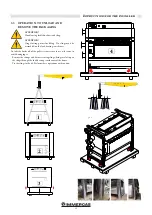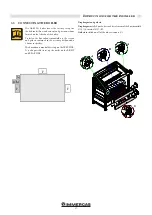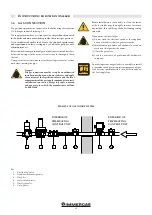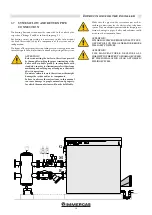
7
1
2
3
4
5
2
7
1
6
General information
1.7 WATER TREATMENT
Treating the supply water allows you to prevent problems and
maintain the functionality and efficiency of the generator over time.
The purpose of this treatment is to eliminate or significantly reduce
problems that can be outlined as:
build-up
corrosion
sediments
biological growth (mould, fungus, algae, bacteria, etc.)
The chemical analysis of the water provides a lot of information on the
state and "health" of the system.
The pH level is a numerical indication of the acidity or alkalinity of
a solution.
The pH scale goes from 0 to 14, where 7 corresponds to neutral.
Values below 7 indicate acidity, values above 7 indicate alkalinity.
The ideal pH value in heating systems with aluminium boilers is
between 6.5 and 8, with a hardness of 15°F.
Water in a system with a pH value outside of this range considerably
accelerates the destruction of the protective oxide layer which forms
naturally inside the aluminium bodies, and would not occur naturally:
if the pH level is lower than 6 it contains acid, if it is above 8 the water is
alkaline, either due to an alkaline treatment (for example phosphates or
glycols operating as antifreeze) or in some cases the natural generation
of alkalis in the system.
Vice versa, if the pH value is between 6.5 and 8, the aluminium surfaces
in the body are passivated and protected from further corrosive attacks.
To minimise corrosion, it is essential to use a corrosion inhibitor.
In order for it to work efficiently, however, the metal surfaces must
be clean.
The best inhibitors on the market also contain an aluminium
protection system that stabilises the pH levels of the filler water,
preventing sudden changes (buffer effect).
It is advisable to systematically check (at least twice a year) the
pH value of the water in the system. In order to do so a chemical
laboratory analysis is not required, but a simple check using a
analysis "kit" contained in a carry cases, easily available on the
market.
It will therefore be necessary to set up the devices shown in the figure
in the heating system.
THE COUPLING MUST BE SET UP ON THE
RETURN PIPE TO THE PRIMARY CIRCUIT
DOWNSTREAM OF THE PUMP.
All of the precautions required to avoid the formation and localisation of
oxygen in the water of the system. For this reason the plastic pipes used
in the under-floor heating systems must not be permeable to oxygen.
Make sure that any anti-freeze products are compatible with aliminium
and any other parts and materials in the system.
ATTENTION!
Any damage caused to the boiler, due to the formation
of build-up or corrosive water, will not be covered by
the warranty.
ATTENTION!
These appliances are designed and developed to
transfer heat to a heat carrying fluid possessing the
characteristics described here, they are not suitable to
directly heat water intended for human consumption.
Key:
1 - Ball valve
2 - Sample trap
3 - Filling unit
4 - Cut-off device
5 - Water treatment unit
6 - Litre meter (recommended)
7 - "Y" strainer
Example of water treatment unit








































